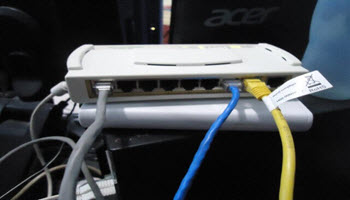So I have four towers, most used for backup purposes but not enough jacks on the back of my router to plug them all in. There are four plugins on the back but I have to keep my cable box plugged into one for the cable TV to work (hate that setup). I recently tried using a USB wireless adapter on my fourth computer to connect it to my network. I had a bit of trouble with drivers for the USB device but finally got it working but then realized another problem.
Speed. I had recently made a backup image of my Asus computer (Win 10) and was going to copy the backup image to my computer that I call XPTO7 because it was originally a Win XP upgrade to Win7. The file was roughly 50GB in size and the estimated copying time? 22 hours — not acceptable.
I needed a faster connection. I have a couple of old routers around and maybe a switch or two. I figured I could chain one or the other together to add additional ports. I decided to go with a network switch. In this case, an 8Port 10/100Mbps N-Way Switch.
The first thing I had to do was unplug one of my computers from my router and plug it into the switch then plug that switch back into the router. I first plugged the router into the port on the far-right, thinking it was an uplink port and then I plugged XPTO7 into the switch. When I tried to access the network on XPTO7, I had no access. I tried all the fixes and tweaks including running the network troubleshooter.
But nothing. So I took a look at the up-link port and it turns out it wasn’t an uplink port but rather a Daisy Chain port. If I needed to add another switch I would plug it in there. I assumed it was an up-link port because I had a smaller switch before, a 5-port with an up-link port for plugging in your modem or router.
So I plugged the router (the yellow wire in my picture) into the first port, Then XPTO7 into the second (the blue wire). So then I went back to XPTO7 but still no network access, so I ran the troubleshooter again. This time, it worked.
Then I had to plug my last computer in, my Acer with Windows 7 (the gray wire). I have no excuse for why I put it on the other end. At this point, the numbering of the ports is not relevant, so, at your own discretion. But then I still had to run the troubleshooter to get that connection cleared out. I think if I just restarted all my computers after the network changes it might have cleared everything out.
Unlike a router, this switch doesn’t have an interface or settings that you can configure, so you plug it in, and either it works or doesn’t. FYI: as I understand it, you can get switches that you can manage like routers with a software interface. And by the way that 22-hour copying job was cut down to 1 hour 25 minutes.
—



For residential use, unmanaged switches will suffice for most users. I have a 24 port switch plugged into my router and a 16 port plugged into that as well as an 8 port POE switch. I also have another 8 port POE switch plugged into the router. And that’s just in my “server room!” In other rooms I have 5 and 8 port switches in use as needed. Several years ago I upgraded to gigabit switches which noticably improved performance.
I’m pretty sure I’ll never need that many switches. 🙂 For now, what I have suited my needs. Thanks for the comment.